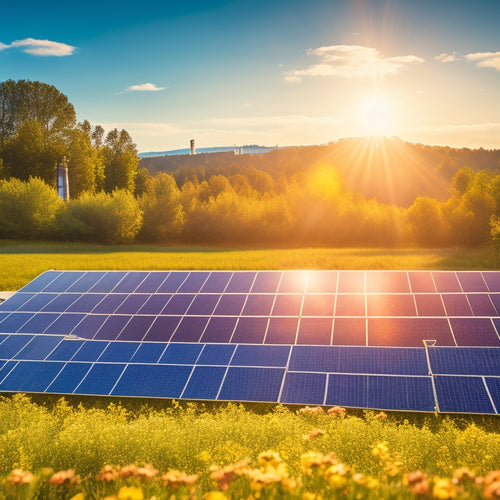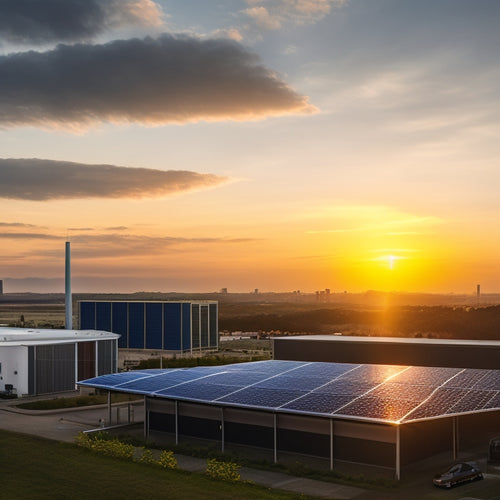
What Optimizes Panel Energy Efficiency?
Share
To optimize panel energy efficiency, you'll need to focus on several key factors. First, guarantee precise installation and orientation of your panels, considering location-dependent ideal angles and seasonal adjustments. Minimize shading and reflection by cleaning your panels regularly and using technologies like solar film. Control temperature and humidity to prevent energy losses, and optimize your inverter and wiring configuration to reduce energy waste. Finally, implement monitoring systems to track performance and identify areas for improvement. By fine-tuning these elements, you'll be on the path to maximizing your panel's energy output – and there's even more to uncover.
Overview
- Precise panel installation and orientation maximize energy output, with ideal angles dependent on location and season.
- Shading and reflection minimization, along with regular cleaning and maintenance, ensure optimal energy harvesting.
- Regulating temperature and humidity within ideal operating ranges enhances panel performance, with geographical factors influencing optimal conditions.
- High-efficiency inverter technology and optimized wiring configurations reduce energy losses and improve overall energy production.
- Continuous monitoring and performance tracking enable proactive maintenance, benchmarking, and optimization strategies for peak energy efficiency.
Panel Angle and Orientation Matter
When it comes to utilizing solar energy, every degree counts. You need to verify your solar panels are installed with precision to maximize energy output.
Panel placement and orientation are critical, as slight misalignments can lead to significant energy losses. Consider your geographical location and adjust your panels accordingly, factoring in the ideal angle for south-facing panels, which is location-dependent.
In regions with distinct seasonal changes, make seasonal adjustments to enhance energy harvesting, as seasonal variations due to Earth's axial tilt affect sunlight angles. For instance, tilt your panels at a steeper angle during winter to compensate for the lower sun angle.
Shading and Reflection Minimization
Optimizing panel placement and orientation is just the first step in maximizing energy output.
Now, you need to take into account shading and reflection minimization to guarantee your solar panels operate at peak efficiency. Regular cleaning can also improve energy output by up to 25% Regular cleaning, and proper placement minimizes shading from trees and structures.
Shading from trees, buildings, or other obstructions can greatly reduce energy output. To combat this, you can install shading devices, such as louvers or overhangs, to block direct sunlight during peak hours.
Additionally, solar film technologies can be applied to reduce reflection and increase energy absorption. By minimizing shading and reflection, you can increase your solar panel's energy output, giving you more freedom and independence from the grid.
Cleanliness and Maintenance Schedules
Efficiency hinges on routine attention to cleanliness and maintenance, as even a thin layer of dust or debris can diminish energy output.
Regular cleaning can enhance energy output by up to 10% Clean Your Way, and neglecting to clean your panels can lead to energy output reduction of up to 25%.
You should establish a regular solar panel cleaning schedule to guarantee peak performance. The frequency of cleaning depends on your location and environmental conditions.
If you're in a dusty or polluted area, you may need to clean your panels every 2-3 months. In cleaner environments, cleaning every 6-12 months may be sufficient.
Regular maintenance also involves inspecting your panels for signs of wear or damage. Check for loose connections, corroded terminals, and damaged glass or frames.
Temperature and Humidity Control
You're likely aware that temperature and humidity extremes can greatly influence panel energy efficiency.
To maximize performance, you need to operate within ideal temperature ranges and maintain humidity levels below specific thresholds.
Ideal Operating Ranges
Regulate temperature and humidity levels within a narrow range to release ideal panel performance. You achieve this by considering system design, energy storage, and panel materials that operate efficiently within specific temperature ranges.
Installation quality also plays an essential role, as it affects the panel's ability to dissipate heat. Geographical considerations, such as altitude and latitude, impact the ideal operating range, and seasonal adjustments may be necessary to optimize energy production.
Effective load management and compliance with energy regulations guarantee your system interacts seamlessly with the grid. By benchmarking your panel's performance, you can identify areas for improvement and make data-driven decisions to maximize energy efficiency.
Humidity Thresholds Matter
By fine-tuning your system to operate within ideal temperature ranges, you've set the stage for maximizing energy production.
However, don't overlook the essential role humidity plays in enhancing panel energy efficiency. You see, excessive moisture can greatly impede energy production. When humidity levels exceed the recommended threshold, it can lead to energy losses and even damage your equipment.
Effective moisture management is critical to mitigate the humidity impact on your system. By setting humidity thresholds that align with your equipment's specifications, you'll guarantee peak performance and extend its lifespan.
Implementing a strong moisture management strategy will help you maintain a stable and efficient energy production environment.
Stable Temperature Control
Within the delicate balance of panel energy efficiency, stable temperature control emerges as an vital factor, working in tandem with humidity management to guarantee peak performance. As you aim for ideal energy management, you must consider the impact of temperature fluctuations on your panel's output. Thermal insulation plays an important role in maintaining a stable temperature, allowing your panel to operate within its ideal range.
| Temperature Range | Energy Efficiency Impact | Recommended Insulation |
|---|---|---|
| 15°C - 30°C | Ideal performance | Standard thermal insulation |
| 30°C - 40°C | Slightly reduced efficiency | Enhanced thermal insulation |
| 40°C - 50°C | Noticeable efficiency loss | Advanced thermal insulation |
| 50°C - 60°C | Significant efficiency loss | High-performance thermal insulation |
| Above 60°C | Critical efficiency loss | Customized thermal insulation solutions |
Inverter and Wiring Optimization
When optimizing your panel energy efficiency, you'll want to focus on reducing inverter losses, as these can greatly impact overall energy production.
You'll also need to contemplate wiring configuration, as a well-designed wiring layout can minimize energy losses and maximize system performance.
Inverter Loss Reduction
In optimizing panel energy efficiency, inverter loss reduction plays a vital role, as inverters are a significant contributor to energy losses in solar panels.
You can minimize these losses by selecting high-efficiency inverter technology that meets rigorous efficiency standards. This not only reduces energy waste but also increases your inverter's lifespan.
Make sure your inverter is grid-compatible and can optimize power output to match your system's integration needs. Proper installation practices, thermal management, and load balancing are also essential to minimizing losses.
To gauge your inverter's performance, track key performance metrics such as efficiency, power output, and temperature.
Wiring Configuration Matters
Configured correctly, your solar panel system's wiring can greatly impact its overall energy efficiency. You can optimize energy production by selecting the right wiring configuration.
Series connections allow for higher voltages, reducing wire gauge and voltage drop, while parallel configurations provide added flexibility and redundancy. Proper wire gauge selection guarantees minimal energy loss due to resistance.
Additionally, incorporating circuit protection and load balancing guarantees electrical safety and efficient energy distribution. When installing your system, consider advanced installation techniques, such as optimized grounding methods, to minimize energy loss.
Monitoring and Performance Tracking
You're tasked with maximizing the energy efficiency of your panel system, and that requires a thorough comprehension of its performance.
Monitoring and performance tracking are essential aspects of this process. By leveraging advanced data analytics, you can gain significant understandings into your system's energy production, consumption, and overall efficiency.
This allows you to identify areas of improvement, optimize energy forecasting, and make data-driven decisions to enhance performance.
With real-time monitoring, you can detect potential issues before they become major problems, ensuring your system operates at peak efficiency.
Frequently Asked Questions
Can Energy Efficiency Be Optimized for Panels Installed in Shaded Areas?
When you install panels in shaded areas, you'll face reduced energy output due to shading effects, but you can optimize performance by using specialized inverters, optimizing panel tilt and angle, and implementing smart monitoring systems to maximize energy yield.
How Often Should I Inspect My Solar Panels for Damage or Defects?
You should inspect your solar panels quarterly for damage or defects, ensuring ideal panel maintenance, and consider increasing inspection frequency after severe weather events or when noticing performance drops to maximize energy harvest.
Are Energy-Efficient Panels More Expensive Than Regular Ones?
As you weigh your options, remember that energy-efficient panels may come with a higher initial cost, but you'll reap long-term savings, breaking free from energy bills and embracing the freedom to utilize the sun's power.
Can I Optimize Energy Efficiency With a DIY Solar Panel Cleaning Kit?
You can optimize energy efficiency with a DIY solar panel cleaning kit by implementing regular solar panel maintenance, utilizing effective cleaning techniques, and ensuring dust-free surfaces, thereby maximizing your panel's energy output and enjoying the freedom of renewable energy.
Do Energy-Efficient Panels Work Well in Extremely Cold Climates?
You might think cold climates hinder solar panel efficiency, but you'll be surprised - energy-efficient panels, with proper solar panel insulation, can thrive in freezing temperatures, ensuring consistent energy generation even in the chilliest of winters.
Ready to Buy
By mastering these essential factors, you'll release a solar panel system that's a powerhouse of efficiency! Every watt will be coaxed out, every photon captured, and every electron optimized. Your system will hum like a finely tuned machine, spewing out clean energy like there's no tomorrow. The result? A staggering reduction in your carbon footprint and a wallet that's noticeably heavier. The ultimate victory: you'll be basking in the glory of a truly optimized solar panel system!
Related Posts
-

Advantages of Solar Generating Systems Over Traditional Energy
Solar generating systems provide several key advantages over traditional energy sources. You'll experience lower long...
-
Average Lifespan of Solar Battery Banks
The average lifespan of solar battery banks generally ranges from 5 to 15 years. This variation mainly stems from the...
-

Advantages of Commercial Solar Battery On-Site Storage
By investing in a commercial solar battery on-site storage system, you can greatly reduce your energy grid dependence...

